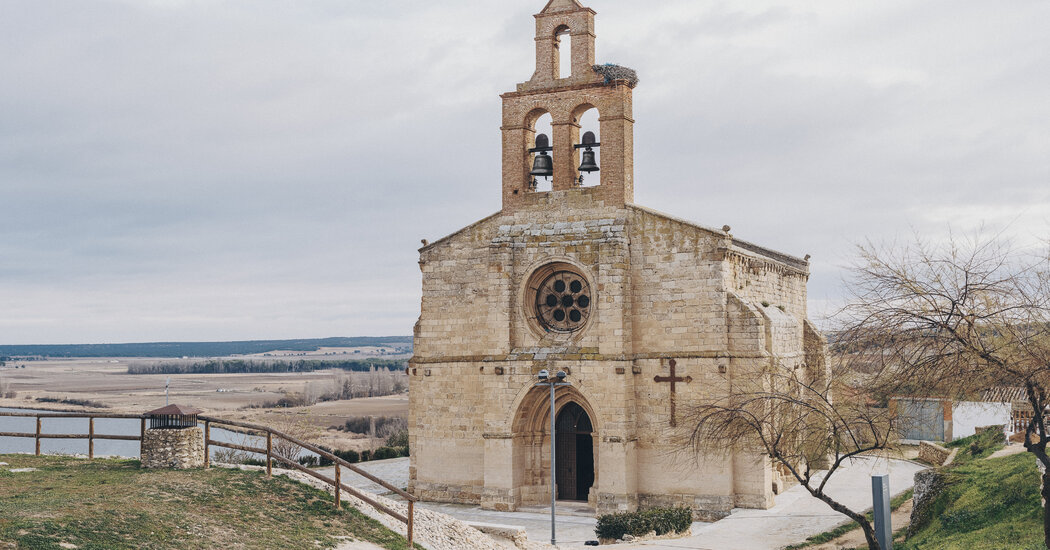CASTRONUÑO, Spain — The Romanesque church that sits above the river within the Spanish village of Castronuño used to seem like many others that dot the land: not too decrepit for a 750-year-old, however not significantly well-kept both.
Then in November, Mayor Enrique Seoane observed one thing that gave him a shock and prompted a scandal in Spain.
In a photograph taken by one in all his neighbors, Mr. Seoane spied a seam of very trendy cement that somebody had poured right into a decidedly historic archway. It was an obvious selfmade restore job to maintain the church’s japanese flank from falling in.
The work was performed by an unknown “masked restorer,” the mayor instructed a neighborhood journalist in a narrative that quickly unfold throughout Spain.
Whereas this may conjure visions of a superhero secretly coming to the help of an getting old church, that’s not how the mayor’s phrases performed in Spain. As an alternative, they stirred up dangerous reminiscences in a rustic whose small cities and villages had been scarred earlier than by the eyesores these type of vigilante restore efforts depart behind.
The determine of do-gooder gone dangerous was epitomized in Spain by Cecilia Giménez, a grandmother then in her 80s, who made headlines around the globe after her botched restoration of a century-old fresco of Jesus topped with thorns known as “Ecce Homo.” The consequence was so bungled, authorities at first thought the portray had been vandalized.
Spain’s artwork and structure conservators vowed to cease these novice, and undesirable, restorers.
But in Castronuño, in Valladolid Province northwest of Madrid, a mysterious somebody had struck once more, this time on the Church of Santa María del Castillo, constructed round 1250 within the late-Romanesque fashion by the Knights Hospitallers of St. John of Jerusalem.
Miguel Ángel García, the spokesman for the Valladolid Province Heritage Affiliation, a small consortium of native residents who attempt to stop this sort of travesty, amongst its different conservation efforts, had come for a take a look at the harm on a latest chilly night. He gazed up on the cement, ruefully, as wind blew via a stork’s nest within the church’s bell tower.
“The story of the ‘Ecce Homo’ simply retains repeating itself all around the nation,” he mentioned.
It could possibly be mentioned that the issue of Castronuño is the issue of Spain: This historic land simply has too many aged issues in want of fixing. There are Phoenician forts, Celtic castles, Moorish minarets, Roman ramparts, granite Greek graves — all left by bygone civilizations that got here right here conquering, all bent on leaving one thing for posterity.
Even the identify of the Spanish heartland, Castille, means one thing like “land of castles,” since so many have been constructed after 800 years of battles between Christian and Muslim rulers.
As she stood outdoors Castronuño’s broken church on a latest day, Mar Villarroel, a youngsters’s guide author who doubles because the hamlet’s part-time tourism promoter, noticed that if Spain’s blessing was that it had a lot historical past, then its curse was that a lot was prone to being misplaced for neglect.
Take the outdated fortress, she mentioned, for which the village had been named, however that had been razed by Ferdinand II of Aragón within the time of Columbus. Or Castronuño’s first church — constructed even sooner than the one in use right this moment, however demolished in 1919 (a long time after its roof had fallen in).
Extra not too long ago, the villagers had been begging the federal government and the native Roman Catholic Archdiocese to return repair Santa María del Castillo earlier than it suffered an analogous destiny.
However with no signal that any assist was on the way in which, somebody was moved to take issues into their very own grossly misguided arms.
“The cement is a scandal, it’s ugly, sure,” Ms. Villarroel mentioned. “However you need to know the actual scandal? It’s that these in cost let the church get this fashion.”
José Antonio Conde, a type of church caretaker known as a sacristan, was looking for the important thing on a latest night. Solely 4 individuals had copies, he mentioned, and a minimum of three gave the impression to be out of city. Lastly, a sister of 1 picked up the telephone. He darted off to search out her.
Minutes later, he swung open the outdated creaky door. The church was almost darkish, and as eyes adjusted to the dim, the inside got here slowly into view: an extended nave, an outdated stone roof and a crucifix on the altar in entrance of a purple drape. The massive river stones that had been hauled up the hill throughout building had every been signed with the mark of the traditional mason who had lower them.
Mr. Conde discovered the sunshine swap, and the remainder of the church was instantly seen.
The harm couldn’t have been extra clear. Years of water seeping into the partitions from outdoors had left lengthy white mineral stains, giving the looks of a cave’s inside.
The retablo, the grand cabinets manufactured from wooden that sit behind the altar, had been professionally restored, however the moisture was threatening them once more. It was too late for the 18th-century frescoes that when confirmed scenes from the lifetime of Jesus: Just one was absolutely seen, of Christ carrying the cross.
“You may nonetheless make them out after we have been youngsters,” mentioned Manolo Brita, a buddy of Mr. Conde’s, who had walked in behind him.
Mr. Conde, pointing as much as the choir close to the outdated rosette window, recalled a special reminiscence from childhood, now many a long time gone. “I keep in mind when that choir was stuffed with youngsters,” he mentioned. “It’s not now.”
And that absence, he mentioned, was the actual cause the church was crumbling: as a result of the village’s inhabitants was dwindling and there have been few left to take care of it anymore. The inhabitants had fallen from greater than 1,500 when he was younger to round 860 right this moment, a part of a rural flight that has villages throughout Spain.
Whereas the mayor’s report this fall of a “masked restorer” had set off indignant requires an investigation to search out the perpetrator, data that surfaced later each difficult the whodunit and emphasised simply how lengthy these errant interventions had been plaguing the nation.
A neighborhood resident, wanting via an getting old guide concerning the church buildings of the area, observed a picture that confirmed the identical seam of cement over the archway a minimum of as early as 1999, when the survey had been printed. With the crime apparently a minimum of 20 years outdated, it appeared there could be no discovering out who did it.
Sitting in his workplace, Mr. Seoane, the mayor, mentioned he regretted if his phrases had made individuals suppose there could be a manhunt for the perpetrator. However the truth that nobody had observed the cement had been there all these years was telling too, he mentioned.
And it wasn’t simply the mishandled cement restore job that was now inflicting individuals to do a double take. Who had put in the alarm system that appeared drilled into the traditional stone? Or the cumbersome electrical conduit that jutted out of one of many historic home windows? It appeared to have been there for years, principally unnoticed.
And why was there wire mesh overlaying over the rosette window, and who had put it there?
The listing of impromptu restore jobs now being observed on the church swiftly appeared countless. However a minimum of the botched cement job — and the mayor’s colourful if fictional description of the perpetrator’s look — had gotten everybody’s consideration, sufficient that Mr. Seoane thought he may lastly get the funding to repair the opposite objects that wanted restore.
“If we don’t get the job performed this time,” he mentioned, “I don’t suppose we ever will.”
José Bautista contributed reporting from Castronuño.

